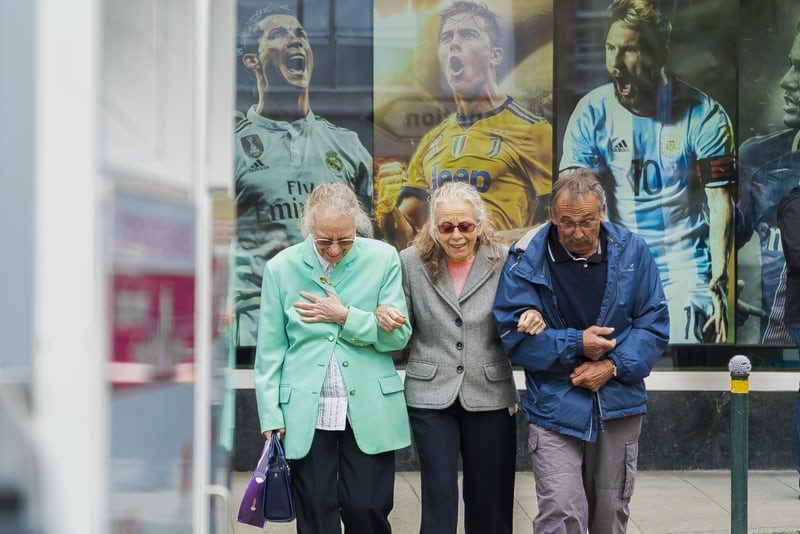

Mar 03, 2022
By 2040, a quarter of us in the UK will be over 60, and people over 55 will account for 63p spent in every £1. People over 50 will make up 40% of total earnings. And it’s not just the UK.
The world is experiencing a seismic demographic shift. Life expectancy is increasing, birth rates are declining, and by 2050, there will be 10 billion people on earth, compared to 7.7 billion today. This shift will mean that globally, the working-age population will see a 10% decrease by 2060. The number of elderly people per 100 working-age people will nearly triple - from 20 in 1980, to 58 in 2060.
Simply put, in the coming decade some societies will, for the first time, have more old people than young people, and, if you believe Elon Musk, civilisation will crumble if we don’t increase the population. A declining workforce will lead to economic turmoil and eventual collapse.
Economically, ageing has usually been perceived as negative. Retirement, pensions, ill-health and reliance on the state for support have been seen as economic burdens on society, funded, in large part, by the younger working population with services delivered by the third sector.
Combine this with the continuing digital divide, pensioner poverty increasing and an epidemic of loneliness and isolation further reinforced by the restrictions of the pandemic and you’d think the outlook was fairly bleak?

We need to act now to future proof our products, services, homes, neighbourhoods and workplaces to respond to the needs of a growing older population.
We have a unique opportunity to tap into the enormous potential of the longevity economy by moving away from primarily focusing on the negative aspects of ageing e.g. illness and frailty, and better responding to the needs, wants, interests, aspirations and demands of an ageing audience.
As Madeleine Albright once put it, “we are taking 21st century challenges, evaluating them with 20th century ideas and responding with 19th century tools.” At Good Futures we believe it’s time to change the narrative on ageing. It’s time to put to bed old myths about health, politics, digital literacy, giving and purpose. We need to stop defining older people by their (and our) worries and perceived deficits.

Boomers (born between 1946 and 1964) control a disproportionate amount of assets, owning around 80% of UK private wealth. They were the first mass consumer generation - they wanted it, they got it.
As they enter retirement, commercial interest in services and products that speak to this audience is only going to increase. Investment from pharmaceutical companies, tech interventions in health and social care, financial management services, new approaches to housing and development, and solutions for loneliness and isolation are just the tip of the product pathway.
However the future of ageing isn’t just about older audiences. Ageing is an intergenerational issue, with implications for everyone. How do we move from managing crises to prevention and preemption? How do we address inequality upstream? How do we all live intentionally instead of waiting till retirement to find meaning and purpose?
And there are some hard questions to confront. As innovations in medicine and technology extend life expectancy, how long should we live? Should there be exclusions to treatment based on age? With an ageing population, how do we ensure younger generations have a voice and influence? And as we live longer and work longer what does this mean for the future of work and the workplace?
There’s a lot to be hopeful about. And there’s a lot to cover in the next 12 weeks.
Welcome to the future of ageing.

Before we dive into the trends, we wanted to give you a flavour of some of the topics we’ve been exploring in our research. Next week we’ll be kicking off with an article about ageing assumptions, and looking to break some of the biggest myths that abound in the third sector about ‘older people’. It’s time to say goodbye to Dorothy, and hello to a new cohort of thrill seeking, resilient, curious and passionate donors..
Companies like 55 Redefined are changing the way we market to older audiences. Gone are the incontinence pads and Stannah stairlifts. In, are digital vaults, recruitment boards and tailored lifestyle and fitness advice.
Sister Madonna Buder, also known as the Iron Nun, currently holds the world record for being the oldest woman ever to finish an Ironman triathlon. She completed her first triathlon at the age of 52, after being introduced to running by a priest. She’s now 91 and still completing.
The Old Gays (yes that really is their TikTok handle) have over 6m followers on the platform. They’re part of a growing wave of ‘granfluencers’ - older social media influencers who are both entertaining and inspiring to younger audiences. Accidental Icon (Lyn Slater) uses fashion to fight against stereotypes of ageing and invisibility.

The desire for sex, intimacy and romantic relationships doesn’t diminish with age. A 2017 University of Michigan National Poll on healthy ageing asked a national sample of US adults ages 50 to 80 about their perspectives on sex and relationships. The results showed that nearly two in three respondents (65 percent) were interested in sex, and most (76 percent) agreed that sex is an important part of a romantic relationship at any age. Forty percent of respondents indicated that they were still sexually active.
However conversations about sex are still seen as taboo in some circles. Old assumptions about women’s sex drive post-menopause have stopped some health professionals from proactively engaging older people in conversations about their sexual health. Whilst the combination of rising divorce rates, the ubiquity of dating apps, and public health messaging about STI prevention having been mainly targeted at younger audiences, has resulted in a jump in new diagnoses of sexually transmitted diseases in older populations.
There is good news. Orgasms can help extend your life expectancy. A four-year Welsh study found that men who had two or more orgasms a week died at a rate half of the men who had orgasms less than once a month. Whilst an eight-decade study on married heterosexual couples found a link between orgasms, health, and longevity, particularly in women who orgasmed frequently, who lived longer than their female counterparts who didn't.

The inevitability we all face (at the moment at least) is that we will all die. How we plan for, manage and process death, grief and end of life is going through changes.
Psychedelic medicines may represent a new frontier for end-of-life care. Big pharma and VC investors are spending billions to get in on the ground floor of what could become a new health care industry. From ketamine therapy for anxiety and depression, and the use of MDMA to treat post-traumatic stress disorder, to psilocybin (the active component in magic mushrooms) and LSD to process end-of-life distress in terminal patients.
Palliate is a digital tool developed by Imperial’s Institute of Global Health (and Ivor Williams, who will be speaking at the future of ageing safari). Palliate seeks to improve the access and quality of training and support for carers to administer subcutaneous medications in the home, to support patient preferences for a home death while also reducing pressure on community care teams.
In December 2021 Apple launched a new legacy contact feature for all Apple devices. Legacy Contact enables you to give up to five contacts access to your digital assets (your contacts, passwords, photos and downloads). As more and more of our lives are lived online, being able to plan for your digital estate management isn’t just about accessing memories for your loved ones. Your digital estate has value - from crypto wallets, to NFTs, to digital real estate.
Over the next 12 weeks we’re going to myth bust old assumptions about ageing and older populations, shine a light on new technology and interventions and explore: the future of work and the workplace, future of health, social care and services, relationships and community, longevity and end of life, amongst a host of other things.